Disagreements during team consultations often stem from inconsistent display quality. This friction delays critical treatment decisions and can negatively impact patient care, creating unnecessary risk and uncertainty for everyone involved.
In multidisciplinary consultations and remote collaboration, medical-grade displays deliver consistent and precise imaging through high resolution, DICOM calibration, and low latency. This enhances diagnostic accuracy and accelerates MDT decision-making. Evidence shows that virtual tumor boards can cut patient waiting times by 20–30%, highlighting their critical role in improving clinical teamwork and patient outcomes.

Multidisciplinary Team (MDT) meetings1 are the cornerstone of modern, high-quality patient care, bringing together experts from radiology, surgery, oncology, and pathology. The effectiveness of these meetings hinges on a simple principle: every participant must see the exact same clinical information. When teams rely on consumer-grade monitors, subtle but critical details in medical images can be lost or misinterpreted, leading to diagnostic discrepancies. A surgeon might not see the faint lesion that a radiologist points out, not because of a difference in expertise, but because of a limitation in hardware. This is where medical-grade displays2 become indispensable. By providing unparalleled resolution, standardized image reproduction, and consistent luminance, they create a trusted visual foundation for collaborative decision-making. Using a high-performance display ensures that when a specialist identifies a finding, every other member of the team sees it with identical clarity, fostering consensus and accelerating the path to treatment.
High Resolution and Accurate Image Reproduction for Diagnostic Consistency
When viewing complex scans on standard monitors, specialists may see different levels of detail. This discrepancy can lead to disagreements over findings, slowing down the entire diagnostic process.
High-resolution medical displays ensure all team members see the same critical details, such as microcalcifications or small nodules. This consistency eliminates disagreements caused by poor display quality, fostering diagnostic consensus.
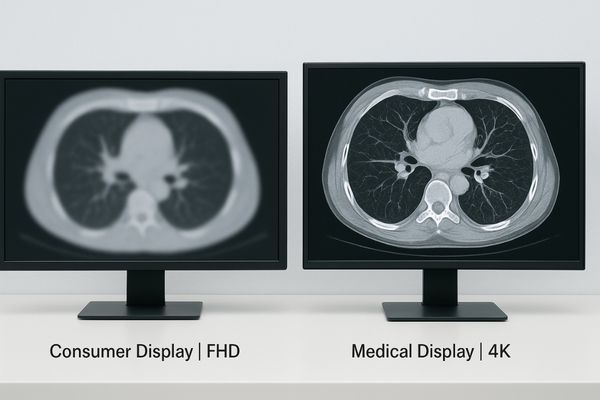
The difference in resolution between a consumer monitor and a medical-grade display3 is not just a matter of numbers; it has a direct impact on clinical accuracy. Medical displays offering 4K or even 8K resolution provide the pixel density required to render the finest anatomical structures with precision. For a radiologist examining a mammogram, this means being able to clearly distinguish between benign and malignant microcalcifications. For an oncologist reviewing a CT scan, it means confidently identifying small lung nodules that might be completely invisible on a standard Full HD screen. Research has consistently demonstrated this advantage, showing significantly higher diagnostic accuracy when using high-resolution medical screens4. During an MDT meeting, this shared level of detail is crucial. It ensures that the visual evidence presented by one specialist is accurately perceived by all others. This eliminates the risk of collaborative friction arising from hardware limitations, ensuring that the team’s discussion is focused on clinical interpretation, not on questioning the fidelity of the image itself.
DICOM Grayscale Calibration and Luminance Uniformity Ensure Cross-Disciplinary Trust
Consumer displays have uneven brightness, causing the same lesion to look different depending on its location on the screen. This inconsistency erodes trust between clinicians during collaborative review.
Factory-calibrated to DICOM Part 14, medical monitors provide uniform luminance and accurate grayscale. This ensures surgeons and oncologists can see the exact subtle details a radiologist highlights, accelerating consensus.
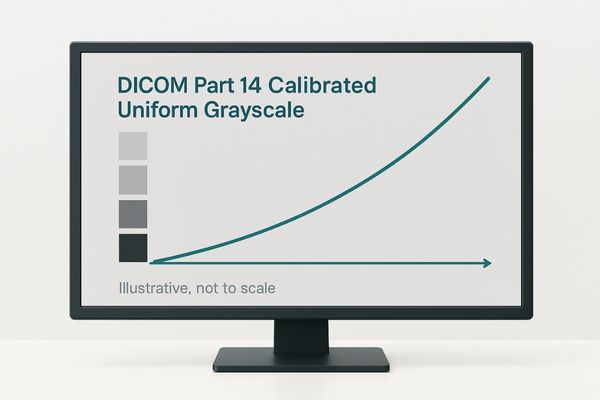
Trust in collaborative diagnostics is built on a shared visual reality, a guarantee that medical-grade monitors5 provide through strict adherence to the DICOM Part 14 standard6. This standard dictates a precise relationship between pixel values in a medical image and the luminance displayed on the screen, ensuring that grayscale representation is perceptually linear and consistent across all compliant devices. While a consumer monitor can exhibit brightness variations of up to 35% from the center to the edges, a medical display maintains near-perfect luminance uniformity. This means a subtle, low-density lesion will appear with the same clarity whether it is in the middle of the screen or in a corner. During a multidisciplinary consultation, this uniformity is essential. When a radiologist points to a faint abnormality on a display like the A430S, they can be confident that the surgeons and pathologists in the room see the exact same finding. This shared, trusted view eliminates ambiguity and allows the team to move efficiently from observation to consensus.
High Brightness and Contrast Enhance Lesion Visibility
On dim, low-contrast consumer screens, critical findings can be easily missed. This is especially true in remote consultations where viewing conditions cannot be perfectly controlled by the specialist.
With luminance levels up to 2000 cd/m² and contrast ratios of 2000:1, medical displays make lesions more visible. This is crucial for remote tumor boards, where clarity prevents misinterpretation.
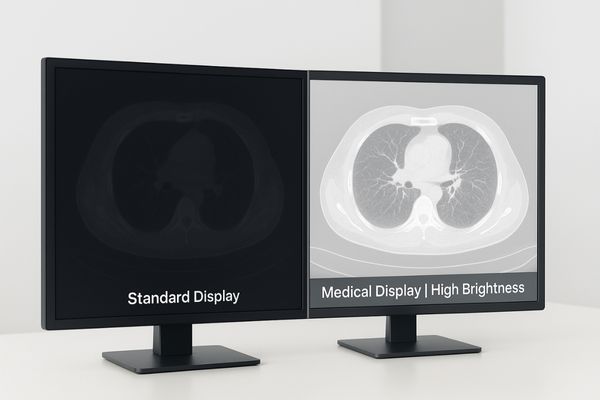
The ability to clearly distinguish a lesion from surrounding healthy tissue is fundamentally dependent on the display’s brightness and contrast capabilities7. Medical-grade diagnostic monitors are engineered to excel in this regard, offering peak luminance levels that can reach 600 to 2000 cd/m², a stark contrast to the typical 300 cd/m² offered by office displays. This high brightness allows clinicians to perceive a wider range of grayscale tones, making subtle pathologies more conspicuous. Furthermore, their contrast ratios often exceed 2000:1, significantly higher than the 500:1 to 700:1 range of standard screens. This creates deeper blacks and brighter whites, enhancing the definition of anatomical structures. These specifications are not just for show; they have a direct clinical benefit. In a remote tumor board meeting, where specialists are viewing images from different locations, the high brightness and contrast ensure that critical findings are not lost due to suboptimal ambient lighting or screen glare. This enhanced visibility is crucial for confident remote diagnosis.
Low Latency and High Refresh Rate Ensure Surgical Collaboration
During interventional procedures, video lag can disrupt a surgeon’s hand-eye coordination. This delay introduces risk and reduces the efficiency of real-time collaboration with remote specialists.
Medical-grade monitors offer low-latency video at 60fps or higher, eliminating lag. This enables real-time collaboration between surgeons and remote radiologists, mirroring diagnostic images directly into the OR.
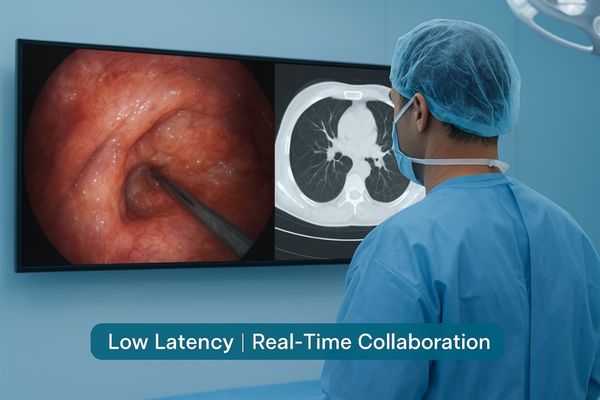
In the dynamic environment of minimally invasive and interventional surgery, real-time visual feedback8 is critical. Medical-grade surgical monitors are designed to process and display video feeds with extremely low latency, ensuring that the image on the screen is perfectly synchronized with the surgeon’s movements. This is essential for maintaining precise hand-eye coordination. This capability also unlocks new paradigms for multidisciplinary collaboration. For instance, at advanced facilities like Sheba Medical Center in Israel, diagnostic images from the radiology department can be mirrored in real time onto large surgical displays within the operating room. This allows a surgeon performing a procedure to consult simultaneously with a remote radiologist, who can provide immediate guidance by referencing the live diagnostic data. This seamless flow of information is only possible with monitors that have a high refresh rate9 (60fps or higher) and negligible processing delay. A large-format surgical display like the A430S facilitates this synergy, enhancing procedural safety and efficiency by bringing multidisciplinary expertise directly to the point of care.
Remote Consultations and Virtual Tumor Boards Enhance Cross-Regional Collaboration
Geographical distance often prevents top specialists from collaborating on complex cases. This can limit a patient’s access to the best possible care and create delays in treatment planning.
Virtual tumor boards, facilitated by high-quality medical displays, ensure remote experts view identical details. This improves communication, reduces treatment decision time, and expands patient access to specialized care.
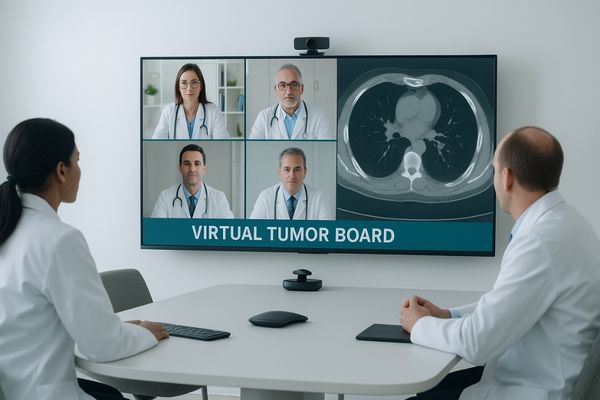
Virtual tumor boards and remote consultations have become vital tools for modern healthcare, breaking down geographical barriers and democratizing access to specialized expertise. The success of these virtual meetings is entirely dependent on the quality of the visual information shared among participants. When every member of a remote team uses a high-quality, DICOM-calibrated medical display10, it ensures information integrity. This means an oncologist in a rural clinic can view a patient’s CT scan with the same diagnostic clarity as a sub-specialist radiologist at a major urban cancer center. Experience from leading U.S. cancer centers shows that this approach can significantly shorten the time it takes to reach a treatment decision, often by 20–30%. It improves communication by creating a common visual ground, minimizing the risk of misinterpretation. By equipping remote sites with capable diagnostic monitors like the A241SPA, healthcare networks can ensure that all patients benefit from accurate, timely, and truly multidisciplinary expertise, regardless of their location.
| Feature | Medical-Grade Display | Standard Consumer Display | Clinical Impact in MDT |
|---|---|---|---|
| Resolution | 4K-8K (e.g., 3840×2160) | FHD (1920×1080) | Ensures all members see fine details, preventing disagreement. |
| Grayscale Standard | DICOM Part 14 Calibrated | Non-calibrated (Gamma 2.2) | Guarantees consistent image appearance for trusted diagnosis. |
| Luminance Uniformity | High (>85%) | Low (Can vary by 30%+) | Prevents lesion visibility from changing based on location. |
| Peak Brightness | 600 – 2000 cd/m² | ~300 cd/m² | Enhances lesion conspicuity, especially in remote settings. |
Healthcare ROI and Long-Term Value of Medical Displays
The high initial cost of medical displays can be a barrier for some institutions. Decision-makers may question whether the investment provides a justifiable return compared to cheaper consumer monitors.
Medical displays have a longer lifespan and lower maintenance costs than consumer monitors. Investing in them is a long-term strategy for quality and efficiency, not just a hardware upgrade.
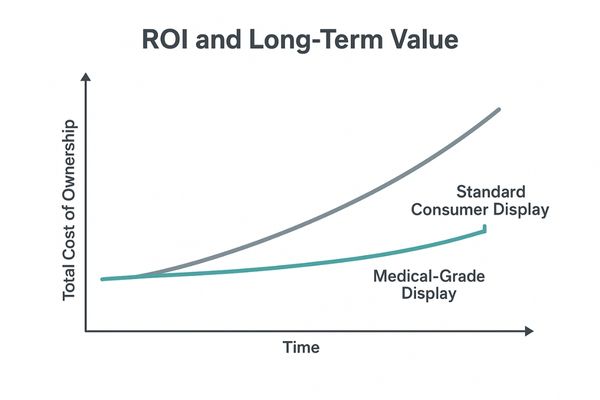
While the upfront purchase price of a medical-grade display is higher than that of a consumer monitor, a simple cost comparison is misleading. The true value is revealed when analyzing the total cost of ownership11 and return on investment (ROI)12. Medical displays are built for durability and longevity, with an average operational lifespan that is often four times longer than their consumer counterparts. They are designed for 24/7 operation in demanding clinical environments. Furthermore, features like built-in sensors for automatic self-calibration significantly reduce the need for manual intervention and ongoing maintenance from IT or clinical engineering departments. This saves valuable staff time and ensures the display remains compliant without extra expense. Industry data reflects a clear understanding of this value; the global market for these devices is projected to grow significantly. Investing in certified medical hardware is a strategic decision that supports long-term quality, safety, and operational efficiency.
Clinical Value and Patient Outcomes in Multidisciplinary Collaboration
It can be difficult to draw a direct line from a piece of hardware to a patient outcome. The impact of a monitor can seem indirect compared to a drug or surgical procedure.
By ensuring teams see the same information, medical displays help them reach diagnostic consensus faster. This shortens the time to treatment and improves outcomes, directly supporting patient care.
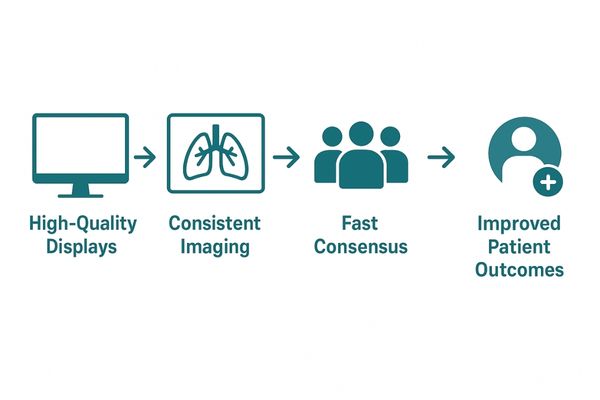
The ultimate purpose of any medical technology is to improve patient outcomes. Medical-grade displays contribute to this goal in a significant, albeit indirect, way. In MDT meetings, their primary function is to create a state of "what you see is what you discuss." By eliminating visual ambiguity and ensuring every team member views the same high-fidelity image, these displays enable faster, more accurate consensus. Studies have shown that effective multidisciplinary collaboration13 is linked to improved patient survival rates and better adherence to treatment plans. By providing the visual foundation for these critical discussions, a high-quality display plays a direct role in this process. It helps shorten the crucial time between diagnosis and the start of treatment, reduces the need for redundant confirmatory scans, and minimizes the risk of diagnostic errors that could lead to inappropriate therapeutic pathways. In this way, the investment in high-quality displays translates directly into enhanced clinical value and a tangible, positive impact on patient care.
Conclusion
Medical-grade displays are essential tools that enable effective multidisciplinary collaboration, leading to faster diagnostic consensus, enhanced treatment planning, and ultimately, improved patient safety and outcomes.
📧 Looking to enhance collaboration in your healthcare facility with medical-grade displays? Contact Martin at martin@reshinmonitors.com for tailored solutions from Reshin.
-
Explore how MDT meetings enhance patient outcomes by fostering collaboration among specialists. ↩
-
Learn about the critical role of medical-grade displays in ensuring accurate diagnostics and effective teamwork. ↩
-
Explore this link to understand how medical-grade displays enhance diagnostic accuracy and improve patient outcomes. ↩
-
Discover the impact of high-resolution medical screens on diagnostics and how they can transform clinical practices. ↩
-
Exploring the advantages of medical-grade monitors can enhance your knowledge of their importance in accurate diagnostics. ↩
-
Understanding the DICOM Part 14 standard is crucial for ensuring accurate medical imaging and diagnostics. ↩
-
Learn about the importance of brightness and contrast in medical imaging for better diagnosis and treatment. ↩
-
Understanding real-time visual feedback can enhance surgical precision and improve patient outcomes. ↩
-
Exploring the significance of high refresh rates can reveal how they enhance surgical performance and safety. ↩
-
Learn about the significance of DICOM-calibrated displays in ensuring accurate medical imaging and diagnostics. ↩
-
Understanding total cost of ownership helps in making informed decisions about medical equipment investments. ↩
-
Calculating ROI is crucial for evaluating the financial benefits of investing in medical-grade displays. ↩
-
Learn about the importance of teamwork in healthcare and its impact on patient survival rates. ↩


